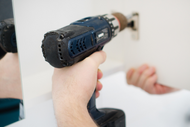DIY Cabinet Installation: How to Install Cabinet Doors
Posted by Donovan Thornhill on Mar 13th 2024

Once you have received your cabinet doors and your doors are sanded, stained, painted, or finished however you like, there’s only one step left—mounting your cabinet doors correctly.
Fortunately, when it comes to cabinet doors, installing kitchen cabinets is a DIY project that anyone can complete without needing prior experience or expensive tools.
In this article, we will show you how to install your custom cabinet doors yourself and get great results. We’ll tell you what you need to do beforehand, and how to manage the process step by step. Believe us—you can do this!
The Benefits of DIY Cabinet Door Installation
There are many benefits to installing cabinet doors on your own. Some of the perks you can look forward to include:
Cost Saving Advantages
For most people, the biggest reason involves cost. If you don’t hang your own doors, you have to pay someone to hang them for you. The cost of a cabinet door installation can be anywhere from $500 to $1,000, depending on the size of your kitchen. Since cabinet door replacement is already a budget-friendly way to transform a space, many people want to keep their project costs as low as possible. Installing kitchen cabinets as a DIY project certainly checks that box.
Understand The Hardware
Mounting cabinet doors on your own helps you familiarize yourself with how the doors work and how hinges are put together. This makes it easier to perform adjustments or repairs later on.
Beginner-Friendly
Installing kitchen cabinets is relatively easy to do! Once you do one, you'll know how to tackle the task step by step. We'll walk you through the steps you need to take for a seamless installation.
How to Prepare for Your Cabinet Door Installation
Before we dive into the step-by-step process, there are a few things you'll need to prep and prepare for the DIY cabinet door installation.
Drilling Holes for Hinges
One of the trickiest parts of learning how to hang cabinet doors is drilling the holes for the hinges accurately. When you order custom-built cabinet doors from Cabinetdoors.com, we offer to drill 35mm hinge holes (with or without pilot holes) into each door for a small fee. Having the holes drilled by a professional saves you a step. It also ensures that when it’s time for you to install cabinet doors, the trickiest part is done correctly.
With 35mm hinge holes, your doors are ready to integrate with most hinges, including Blum soft-close hinges. These hinges are the best option available in terms of performance and longevity. At CabientDoors.com, we design our doors to integrate seamlessly with Blum hinges. You can use whatever hinges you like, but this option makes your DIY project almost foolproof.
Gather The Materials
Next, ensure you have all the necessary materials readily available. You’ll need the following to tackle the task:
- A power drill with an assortment of drill bits
- A #2 Phillips-head screwdriver
- A straightedge or piece of flat lumber to use as a straightedge
- A pencil
- Your doors
- Your hinges
- Any wood screws (provided or required) to attach the hinges
Prep The Cabinets
Before you can start learning how to install cabinet doors, you need to prep and prepare your current cabinets. To get started:
- Remove the old doors and hinges
- Wash down your cabinets and face frames to remove any grease, grime, or buildup
- Wipe down the new cabinet doors you'll be using for the DIY cabinet door installation
- Fill the holes for the old hinges
- Add any necessary finishes to new cabinet doors before installation
Once these steps are complete, you’re ready to install your cabinet doors like a pro!
How to Install Cabinet Doors Yourself
Below, we have provided a quick step-by-step guide for installing cabinet doors. In order to illustrate the easiest way to perfectly hang your own doors, these instructions assume the hinge holes have already been drilled for Blum soft-close hinges. While it is possible to drill your own hinge cups for your new hinges, any mismeasurement can cause a significant problem for you. As such, unless you have experience with hinge-boring and feel absolutely confident in your measuring skills, we recommend opting to have Cabinetdoors.com drill your hinge cups for you.
Once your hinge cups have been drilled into your cabinet doors, whether by you or by us, you’re ready to proceed with installing your hinges and hanging your cabinet doors. Follow these steps, and each door should take a matter of minutes to install and align.
Here’s how to install cabinet doors:
1. Mount the Hinge
Each “hinge hole” includes two smaller 8mm pilot holes on either side of the 35 mm hinge cup. Though they look like the right size for screws, the smaller holes allow this particular type of Blum soft-close hinge to be self mounted. All you have to do is set open the hinge, line up the cup and dowels, and then press down firmly. Now simply lock the hinge in place by clamping down the locking device on the hinge.
2. Attach a Guide
Most cabinet doors have an overlay, meaning the amount the doors lay over the surface opening of the cabinets. For example, ½ inch overlay doors are ½ inch larger than the cabinet opening on all 4 sides. You need to know where the hinges will connect with the cabinet interior based on the overlay, so attach a straight edge ½ inch (or whatever your overlay is) below the cabinet opening.
That way you can rest the door on top of the straight edge and determine exactly where it needs to be positioned. Most people use a flat, straight piece of scrap lumber, but in a pinch you can also draw a line below the cabinet to indicate where the overlay will stop.
3. Mark for the Mounting Plate Pilot Holes
Connect the hinges to the mounting plates. Now rest the door on top of the straight edge so that the mounting plates come into contact with the cabinet face frame. Mark through the holes on the mounting plate to indicate where you need to drill pilot holes. Use a 1/16 inch bit for softwoods like alder or a 3/32 inch bit for hardwoods like oak, hickory, or maple. In both cases, drill the hole to a depth of about ¼ inches in the center of the mark you made on the face frame.
4. Install Bumpers
Many hinge styles, like our Blum soft-close hinges, come with bumpers to help with sound suppression and gentle closing. If bumpers are included with your hinges, install them now as you will need to align your doors with the bumpers in place. Place one bumper each on the top and bottom corners of the door on the side opposite the hinges.
5. Mount the Doors
Our Blum hinges come with the two screws you need to attach the mounting plate to the face frame. Use a #2 Phillip’s head screwdriver to attach the plate where you drilled the holes. Then simply attach the two hinges on each door to the two mounting plates on each face frame. You can do this on your own, but this aspect of installing kitchen cabinets DIY is a lot easier with a helper.
Understanding how the hinge and mount work together is also easier if you explore the mechanism before you mount anything. We created this video to provide helpful information about how the hinges and mounting plates work together.
6. Adjust the Doors for Proper Alignment
Blum hinges allow you to adjust how the doors hang in multiple directions so that they hang and function perfectly. If the doors need to be adjusted up or down, use the screws on the mounting plate to make the adjustment. Adjust until the bottoms of all the doors form a perfect line. For side-to-side adjustments, especially on double doors with a gap in between, use the screw closest to the hinge.
Lastly, make the door sit closer or further from the cabinet frame using the screw furthest from the hinge. With Blum hinges, you will have installed two sound muffling bumpers opposite the hinges. You may need to adjust the doors slightly outward to compensate.
7. Add Finishing Touches
Now that your cabinet doors are mounted and aligned properly, you can add any finishing touches. If you’ll be installing handles, door pulls, or other hardware, you’re ready to do so!
Installing Kitchen Cabinets DIY is Easy With Cabinetdoors.com
Now that you know how to install cabinet doors on your own, it’s time to get started! At Cabinetdoors.com, we strive to make all aspects of cabinet doors easy for you, from selecting your perfect door style, to ordering your doors to your exact specifications, all the way down to DIY cabinet door installation.
Looking for more tips and guidance for learning how to install cabinet doors? Check out our blog, videos, and FAQ section for even more guidance.
If you still have questions or need help with your cabinet doors, feel free to call us at 800-342-1010,contact us via our website, or email us at sales@cabinetdoors.com with specific questions. When it comes to cabinet doors, Cabinetdoors.com always delivers.
We look forward to helping you with your next DIY cabinet door installation!
Frequently Asked Questions About Installing Cabinet Doors
What is an overlay?
An overlay is how much of the doors lays over the surface opening. A 1/2 overlay is recommended.
Are DIY cabinet door installations beginner-friendly?
Absolutely. DIY cabinet door installations are relatively easy and straightforward. If our guide to learning how to install cabinet doors didn't help, we recommend checking out our YouTube channel for a more visual representation of the process.
Should I install the upper or lower cabinets in my kitchen first?
You'll want to start by installing the wall cabinets first. Doing this will reduce the risk of damaging the lower cabinet doors and make it easier to install the rest.
Can I install my cabinet doors by myself?
Yes, a DIY cabinet door installation process is possible. However, you may need an extra set of hands to help you install the upper cabinet doors.


